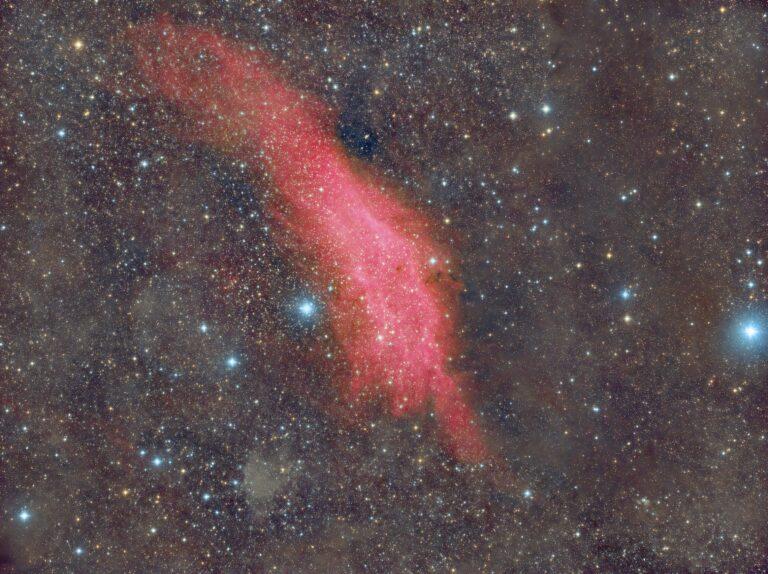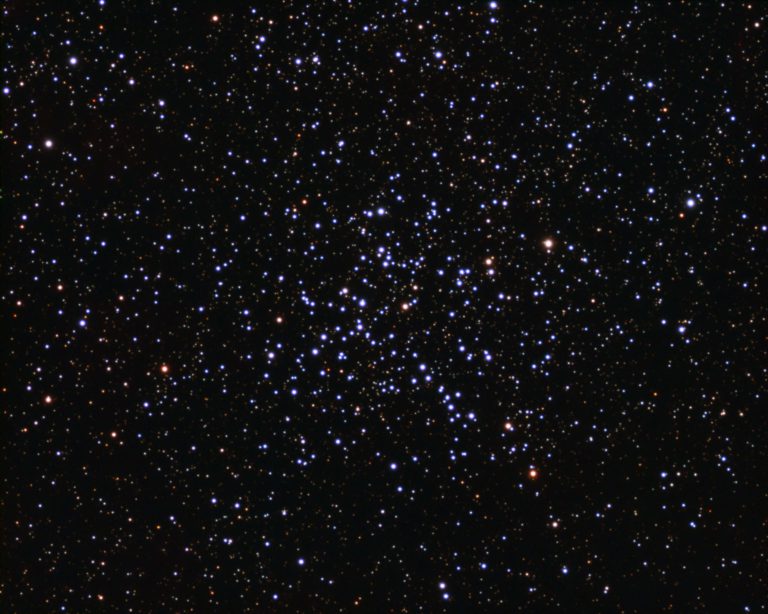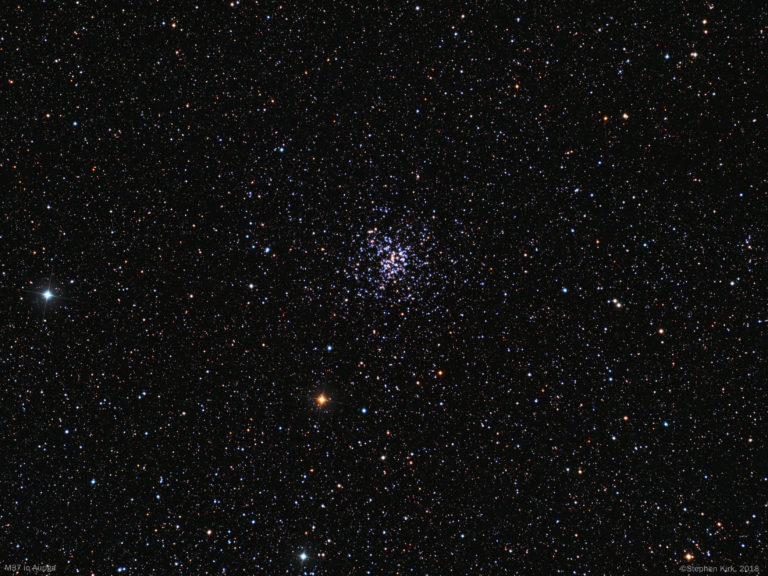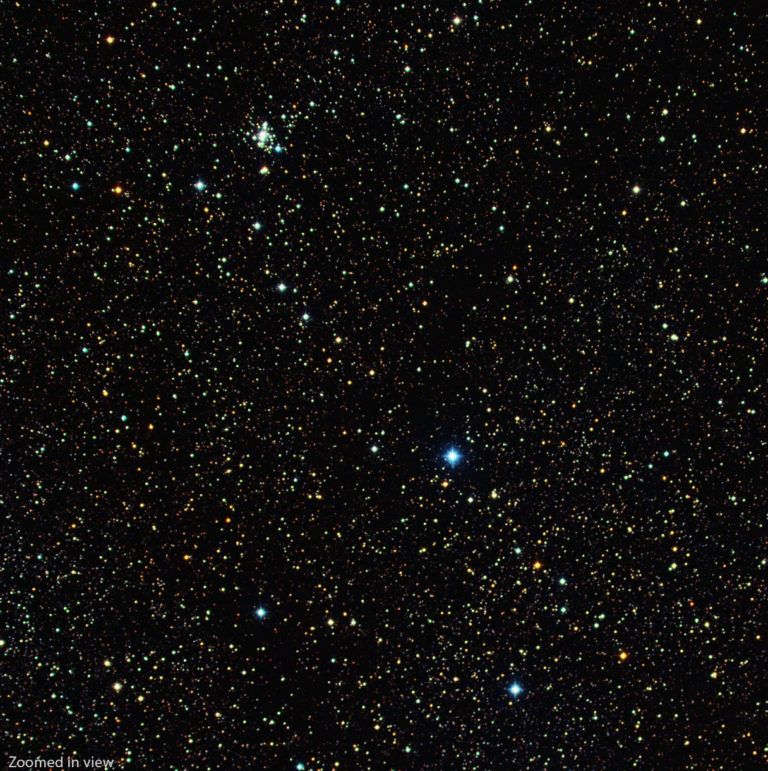The California Nebula – NGC 1499 – is a vast hydrogen gas emission nebula about 1000 light years away in the constellation of Perseus. It is named as such because of its vague resemblance to the US state of California.It is a very large, faint and diffuse object, about four times the diameter of the moon. It is almost completely invisible visually without specialist filters and was not discovered until the advent of astrophotography in 1884. The nebula shines by reflecting the light of the bright star Markib. It shines red because Hydrogen atoms, when excited by nearby bright sources like stars, emit or re-radiate light at the 656nm wavelength which is in the red part of the spectrum to our eyes. The California Nebula Image Technical Data The California Nebula is so large that most telescopes cannot get the nebula in the field of view, nowhere near in fact. …
M38 is the third of three Messier Open Clusters in the constellation of Auriga, in the Northern hemisphere of the sky. The other two Messier clusters are M36 and M37. All of them are easily visible with binoculars and are seen as faint smudges against the darker background. If you read my post on the Constellation of Auriga you will see all three of the Open Clusters in the same image M38 Open Cluster Image Technical Data Imaged from my back yard in Nottingham, UK on the 18th January 2020 whilst high overhead from my location. I used my TEC 140 refractor with Atik 460 cooled CCD camera and Astrodon RGB E Series Generation 2 filters. I used my MESU 200 mount guided with OAG. All exposures binned 1×1: Red > 12 x 180s ; Green > 14 x 180s ; Blue > 13 x 180s. This gives a total integration…
M37 is one of the three Messier Open Clusters in the Constellation of Auriga – the other two being M36 and M38. It is about 4500 light years away and contains several red giant stars, visible in this image, making it the richest of the three Auriga Messier Open Clusters. M37 appears high overhead from my 53 degree norther location during the winter months making it an ideal target for visual observations and imaging. It makes a fine site in a telescope and appears as a fuzzy ball in a pair of binoculars. M37 Image Technical Data Imaged from my backyard in Nottingham, UK on the 9th February 2018. I used my Takahashi FSQ85 refractor and Moravian G2-8300 cooled CCD camera with Astrodon RGB filters. All expsoures are binned 1×1.Red > 12 x 120s ; Green > 12 x 120s ; Blue > 12 x 120s M37 Annotated Version M37…
M44 or “Praesepe” as it is called, is a famous open cluster visible in the late winter/ springtime in the constellation of Cancer – The Crab. It is often nicknamed The Beehive cluster since it resembles a swarm of bees when viewed in a wide-field telescope or binoculars. Along with M45 it is one of the most immediately breathtaking sights in the deep sky. At about 510 light years it is one of the closer Open Cluster to the Earth and is about 12 light years across and contains about 1000 stars. Note the tiny, distant galaxy in the bottom of the cluster PGC24400. M44 (“Praesepe”), The Beehive Cluster Image Technical Data Imaged over two evenings, the 22 and 23 February 2019 from my backyard in Nottingham, UK. Conditions were far from ideal with a high, hazy mist that made transparency poor and subsequent processing difficult. Captured with Takahashi FSQ85…
Kemble’s Cascade in Widefield Setting Kemble’s Cascade (Kemble 1) is a chance straight-line alignment of 17 or so stars between the 5th and 10th magnitudes in the far northern constellation of Camelopardalis. The stars are of different colours and look lovely in a widefield telescope or binoculars. At the end of line of stars is the open star cluster NGC 1502. This asterism is named after the Franciscan monk and amateur astronomer Lucian Kemble. The cascade itself is about three angular degrees in length. Image Technical Data Imaged from my backyard in Nottingham, UK on 14 September 2020. Part of an automated capture sequence and the exposures were taken between 02:00 > 04:00 in the morning. Needless to say I was in bed asleep at the time 🙂 I processed the images afterwards. I used Samyang 135mm DSLR lens connected to my Moravian Instruments G2-8300 CCD camera with Astrodon RGB…





